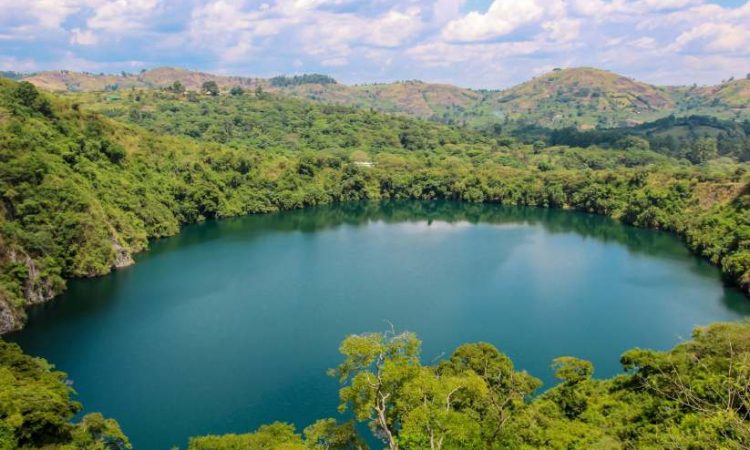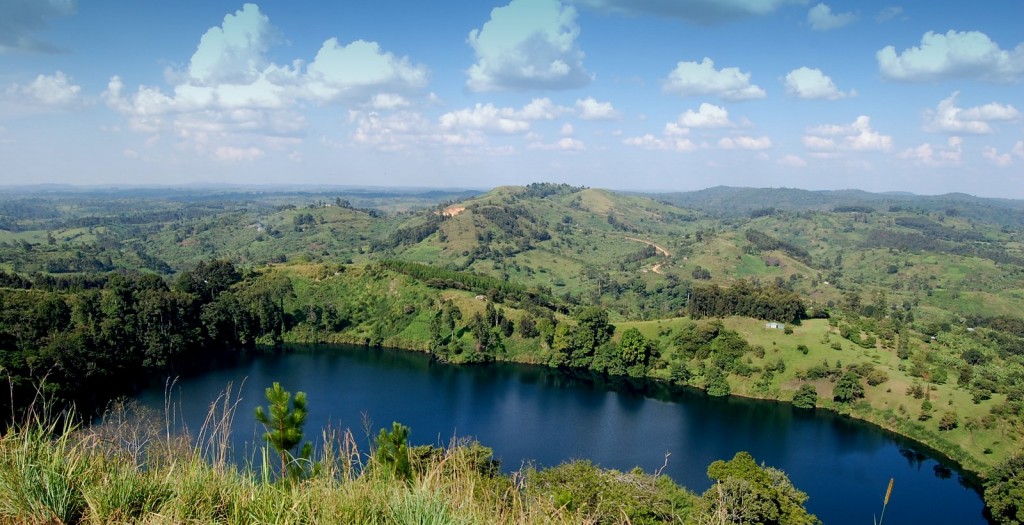Craters of Uganda : All You Need To Know About The Explosion Craters : Crater lakes in Uganda date back 8,000 years as they were developed as a result of volcanic activity. These craters are the consequence of violent volcanic activity or a volcanic fissure; however, unlike other volcanoes that form cones at the mountain’s summit, these explosion craters discharged lava, ash, and boulders that spread far into the surrounding lands, forming a vast basin.

These basins eventually filled with water, forming the crater lakes we know today. Crater lakes offer magnificent views and lush green surroundings. There are numerous crater lakes in western Uganda. If you want to explore the neighboring sights, they could serve as an excellent backdrop for your entire trip. The craters are also excellent sites for safari photography. Here are some of the crater lakes you should see while exploring Uganda:
Katwe Crafter Lake
Lake Katwe is located at the highest point in Queen Elizabeth National Park on the Mweya Peninsula. During your trip to the park, you will have a 27-kilometer view of the beautiful Katwe. The Park is only a short distance away, with a panoramic view of the rift valley, the Rwenzori Mountains, Lake George and Edward, and the Kazinga Channel.
Feel free to visit the Katwe Salt Lake and see how the villagers mine salt. The lake has several inlets but no outflows, which explains why the water is so salty. During the dry season, the salt solution is concentrated by evaporation to produce salt rocks, which are then dried and sold by locals.
Lake Katwe is 996 meters (3,265 feet) deep and heavily salted, making it uninhabitable for animals. However, you will observe the animals when driving to Katwe. You won’t want to miss Lake Kitagata, which is fed by salty water from a salty hot spring, and the stunning vista of the Kyemango Crater.
Interact with the minors, try your hand at some crafts, and take a walk around the lake, among other things. The crater lake is surrounded by limitless lush green flora and hills, which mirror the sky. This creates a wonderful sight for the eyes.
Ndali-Kasenda Craters
The Ndali Kasenda crater field is simpler to reach on foot from Fort Portal, near Kibale Forest National Park. There are numerous crater lakes to explore throughout a 10-kilometer stretch. The famed ‘Top of the World’ crater trail is a three-hour guided tour of the entire crater area. There is much more to see and learn on this walk with your appointed guide.
This is a bit of paradise that most people have not seen. The stunning views of the Rwenzori Mountains, Kibale rain forest, and large tea plantations will captivate you. You can also go mountain biking around these craters. The excitement of hiking in this area grows with each new crater you discover.

The area features numerous crater lakes. Lakes include Nkuruba, Lyantonde, Nyabikere, Nyinambuga, and Kifuruka, among others. Make sure to include chimpanzee tracking on your next trip to Kibale National Park. There are excellent hotel options nearby Kibale National Park and the crater lakes, including the Ndali Lodge, Rweteera Safari Park, and Papaya Lake Lodge.
The Bunyaruguru Craters
These are situated on the western side of Queen Elizabeth National Park. The natives refer to it as the Kichwamba crater fields, and it is located on the Kichwamba escarpment. There are about 20 craters in the Bunyaruguru area, but the most visible is the Nkugute crater lake. Nkugute is located in the newly formed Rubirizi District of Bunyaruguru County. It is claimed to have miraculously transformed into the shape of Africa.
Nkugute is a Runyaruguru word that means snap’ and is based on mythology and ancient stories that have been passed down for generations in the surrounding communities. It was thought that the lake took the lives of a boy and a girl every year. As a result, the term snap’ was used. There was no actual proof to back up this local belief.
The Nkugute crater lake arose as a result of volcanic activity in the Bunyaruguru Volcanic Field, as indicated by the Kitagata hot spring in Sheema. The lake was previously surrounded by dense woodland, but it was cleared during the construction of the Mbarara-Kasese route.
Other crater lakes in Bunyaruguru include the twin lakes of Kyema and Kamweru, Mirambi and Katinda, Nyungu and Rwizongo, Lake Nkuruba, Lake Mafuro, Kamweru and Kyema, and Lake Kamunzuku.
Uganda has more than 50 crater lakes. Although some may be saline and have a strong odor, many have freshwater and lovely scenery, demonstrating the 12,000-year-old development of genuine and breathtaking beauty.
CONCLUSION: CRATERS OF UGANDA
Many of these crater lakes are found in western Uganda, close to and around Kibale and Queen Elizabeth National Parks. A visit to any of the craters can be incorporated into your wildlife safari to Queen Elizabeth or Kibale National Park. Taking the half-day to explore the craters is well worth the time and effort.


